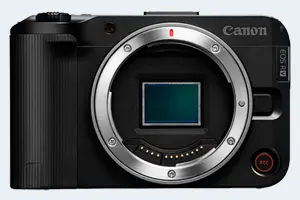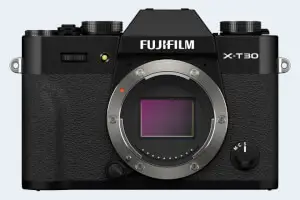Canon R50 V vs Fujifilm X-T30 II
The Canon EOS R50 V and the Fujifilm X-T30 II are two digital cameras that were announced, respectively, in March 2025 and September 2021. Both the R50 V and the X-T30 II are mirrorless interchangeable lens cameras that are equipped with an APS-C sensor. The Canon has a resolution of 24 megapixels, whereas the Fujifilm provides 26 MP.
Below is an overview of the main specs of the two cameras as a starting point for the comparison.

Check R50 V price at
amazon.com

Check X-T30 II offers at
ebay.com
Going beyond this snapshot of core features and characteristics, what are the differences between the Canon EOS R50 V and the Fujifilm X-T30 II? Which one should you buy? Read on to find out how these two cameras compare with respect to their body size, their imaging sensors, their shooting features, their input-output connections, and their reception by expert reviewers.
Body comparison
The physical size and weight of the Canon R50 V and the Fujifilm X-T30 II are illustrated in the side-by-side display below. The two cameras are presented according to their relative size. Three successive views from the front, the top, and the rear are shown. All size dimensions are rounded to the nearest millimeter.
The X-T30 II can be obtained in two different colors (black, silver), while the R50 V is only available in black.
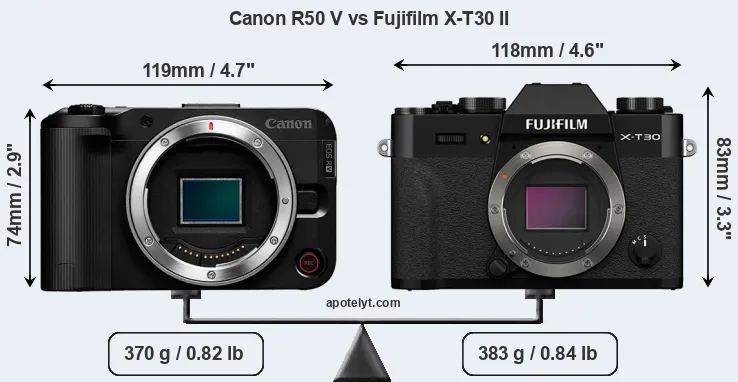

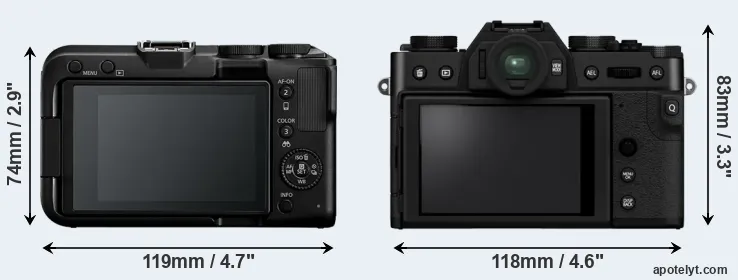
If the front view area (width x height) of the cameras is taken as an aggregate measure of their size, the Fujifilm X-T30 II is notably larger (11 percent) than the Canon R50 V. Moreover, the X-T30 II is slightly heavier (4 percent) than the R50 V. In this context, it is worth noting that neither the R50 V nor the X-T30 II are weather-sealed.
The above size and weight comparisons are to some extent incomplete since they do not consider the interchangeable lenses that both of these cameras require. Hence, you might want to study and compare the specifications of available lenses in order to get the full picture of the size and weight of the two camera systems.
Concerning battery life, the R50 V gets 390 shots out of its Canon LP-E17 battery, while the X-T30 II can take 380 images on a single charge of its Fujifilm NP-W126S power pack. The battery packs of both cameras can be charged via USB, which can be very convenient when travelling.
The adjacent table lists the principal physical characteristics of the two cameras alongside a wider set of alternatives. If you would like to visualize and compare a different camera combination, you can navigate to the CAM-parator app and make your selection from a broad list of cameras there.

| Camera Model |
Camera Width |
Camera Height |
Camera Depth |
Camera Weight |
Battery Life |
Weather Sealing |
Camera Launch |
Launch Price |
Street Price |
||
|---|---|---|---|---|---|---|---|---|---|---|---|
| 1. | Canon R50 V | 119 mm | 74 mm | 45 mm | 370 g | 390 | n | Mar 2025 | US$ 649 | amazon.com | |
| 2. | Fujifilm X-T30 II | 118 mm | 83 mm | 47 mm | 383 g | 380 | n | Sep 2021 | US$ 899 | ebay.com | |
| 3. | Canon M3 | 111 mm | 68 mm | 44 mm | 366 g | 250 | n | Feb 2015 | US$ 679 | ebay.com | |
| 4. | Canon M6 | 112 mm | 68 mm | 45 mm | 390 g | 295 | n | Feb 2017 | US$ 779 | ebay.com | |
| 5. | Canon M50 | 116 mm | 88 mm | 59 mm | 390 g | 235 | n | Feb 2018 | US$ 779 | ebay.com | |
| 6. | Canon M50 Mark II | 116 mm | 88 mm | 59 mm | 387 g | 305 | n | Oct 2020 | US$ 599 | ebay.com | |
| 7. | Canon R10 | 123 mm | 88 mm | 83 mm | 429 g | 450 | n | May 2022 | US$ 979 | amazon.com | |
| 8. | Canon R50 | 116 mm | 86 mm | 69 mm | 375 g | 230 | n | Feb 2023 | US$ 679 | amazon.com | |
| 9. | Canon R100 | 116 mm | 86 mm | 69 mm | 356 g | 400 | n | May 2023 | US$ 479 | amazon.com | |
| 10. | Canon SL2 | 122 mm | 93 mm | 70 mm | 453 g | 650 | n | Jun 2017 | US$ 549 | ebay.com | |
| 11. | Canon SL3 | 122 mm | 93 mm | 70 mm | 449 g | 1070 | n | Apr 2019 | US$ 599 | amazon.com | |
| 12. | Canon V1 | 118 mm | 68 mm | 53 mm | 426 g | 340 | n | Feb 2025 | US$ 899 | amazon.com | |
| 13. | Fujifilm X-E3 | 121 mm | 74 mm | 43 mm | 337 g | 350 | n | Sep 2017 | US$ 899 | ebay.com | |
| 14. | Fujifilm X-E4 | 121 mm | 73 mm | 33 mm | 364 g | 380 | n | Jan 2021 | US$ 849 | ebay.com | |
| 15. | Fujifilm X-T20 | 118 mm | 83 mm | 41 mm | 383 g | 350 | n | Jan 2017 | US$ 899 | ebay.com | |
| 16. | Fujifilm X-T30 | 118 mm | 83 mm | 47 mm | 383 g | 380 | n | Feb 2019 | US$ 899 | ebay.com | |
| 17. | Fujifilm X-T200 | 121 mm | 84 mm | 55 mm | 370 g | 270 | n | Jan 2020 | US$ 699 | ebay.com | |
| Note: Measurements and pricing do not include easily detachable parts, such as add-on or interchangeable lenses or optional viewfinders. | |||||||||||
The price is, of course, an important factor in any camera decision. The manufacturer’s suggested retail prices give an idea on the placement of the camera in the maker’s lineup and the broader market. The R50 V was launched at a markedly lower price (by 28 percent) than the X-T30 II, which puts it into a different market segment. Usually, retail prices stay at first close to the launch price, but after several months, discounts become available. Later in the product cycle and, in particular, when the replacement model is about to appear, further discounting and stock clearance sales often push the camera price considerably down. Then, after the new model is out, very good deals can frequently be found on the pre-owned market.
Sensor comparison
The imaging sensor is at the core of digital cameras and its size is one of the main determining factors of image quality. All other things equal, a large sensor will have larger individual pixel-units that offer better low-light sensitivity, wider dynamic range, and richer color-depth than smaller pixels in a sensor of the same technological generation. Moreover, a large sensor camera will give the photographer more control over depth-of-field in the image and, thus, the ability to better isolate a subject from the background. On the downside, larger sensors tend to be associated with larger, more expensive camera bodies and lenses.
Both cameras under consideration feature an APS-C sensor, but their sensors differ slightly in size. The sensor area in the X-T30 II is 11 percent bigger. As a result of these sensor size differences, the cameras have format factors, respectively, of 1.6 (R50 V) and 1.5. Both cameras have a native aspect ratio (sensor width to sensor height) of 3:2.
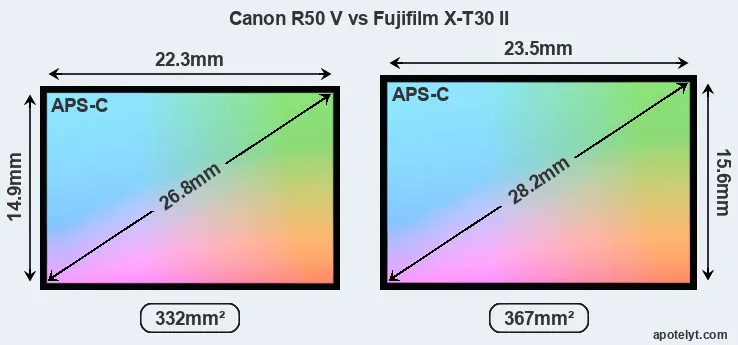
With 26MP, the X-T30 II offers a higher resolution than the R50 V (24MP), but the X-T30 II nevertheless has marginally larger individual pixels (pixel pitch of 3.76μm versus 3.72μm for the R50 V) due to its larger sensor. However, the R50 V is a much more recent model (by 3 years and 6 months) than the X-T30 II, and its sensor will have benefitted from technological advances during this time that enhance the light gathering capacity of its pixel-units. Coming back to sensor resolution, it should be mentioned that the X-T30 II has no anti-alias filter installed, so that it can capture all the detail its sensor resolves.
The Canon EOS R50 V has a native sensitivity range from ISO 100 to ISO 32000, which can be extended to ISO 100-51200. The corresponding ISO settings for the Fujifilm X-T30 II are ISO 160 to ISO 12800, with the possibility to increase the ISO range to 80-51200.
In terms of underlying technology, the R50 V is build around a CMOS sensor, while the X-T30 II uses a BSI-CMOS imager. Like most digital cameras, the R50 V uses a Bayer filter for capturing RGB colors on a square grid of photosensors. In contrast, the X-T30 II employs a more randomized X-Trans layout of photosites, which according to Fujifilm helps to minimize moiré.
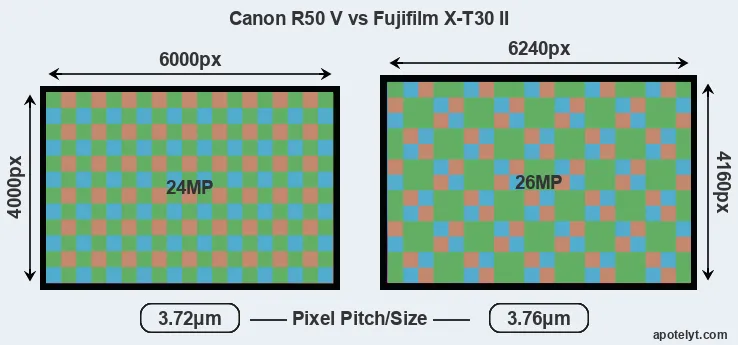
Since 2007, DXO Mark has published sensor performance measurements that have been derived using a consistent methodology. This service assesses and scores the color depth ("DXO Portrait"), dynamic range ("DXO Landscape"), and low-light sensitivity ("DXO Sports") of camera sensors, and also publishes an overall camera score. The following table provides an overview of the physical sensor characteristics, as well as the sensor quality measurements for a selection of comparators.

| Camera Model |
Sensor Class |
Resolution (MP) |
Horiz. Pixels |
Vert. Pixels |
Video Format |
DXO Portrait |
DXO Landscape |
DXO Sports |
DXO Overall |
||
|---|---|---|---|---|---|---|---|---|---|---|---|
| 1. | Canon R50 V | APS-C | 24.0 | 6000 | 4000 | 4K/60p | 24.1 | 14.1 | 2383 | 85 | |
| 2. | Fujifilm X-T30 II | APS-C | 26.0 | 6240 | 4160 | 4K/30p | 24.2 | 13.8 | 2144 | 85 | |
| 3. | Canon M3 | APS-C | 24.0 | 6000 | 4000 | 1080/30p | 22.8 | 11.8 | 1169 | 72 | |
| 4. | Canon M6 | APS-C | 24.0 | 6000 | 4000 | 1080/60p | 23.4 | 12.6 | 1317 | 78 | |
| 5. | Canon M50 | APS-C | 24.0 | 6000 | 4000 | 4K/24p | 23.8 | 13.3 | 1684 | 81 | |
| 6. | Canon M50 Mark II | APS-C | 24.0 | 6000 | 4000 | 4K/24p | 24.0 | 13.6 | 1939 | 83 | |
| 7. | Canon R10 | APS-C | 24.0 | 6000 | 4000 | 4k/60p | 24.1 | 13.8 | 2085 | 84 | |
| 8. | Canon R50 | APS-C | 24.0 | 6000 | 4000 | 4K/30p | 24.1 | 13.9 | 2168 | 84 | |
| 9. | Canon R100 | APS-C | 24.0 | 6000 | 4000 | 4k/24p | 24.1 | 13.9 | 2197 | 84 | |
| 10. | Canon SL2 | APS-C | 24.0 | 6000 | 4000 | 1080/60p | 23.6 | 13.4 | 1041 | 79 | |
| 11. | Canon SL3 | APS-C | 24.0 | 6000 | 4000 | 4K/25p | 23.9 | 13.4 | 1791 | 82 | |
| 12. | Canon V1 | APS-C | 22.1 | 5750 | 3840 | 4K/60p | 23.5 | 13.7 | 1911 | 79 | |
| 13. | Fujifilm X-E3 | APS-C | 24.0 | 6000 | 4000 | 4K/30p | 23.9 | 13.3 | 1764 | 82 | |
| 14. | Fujifilm X-E4 | APS-C | 26.0 | 6240 | 4160 | 4K/30p | 24.2 | 13.7 | 2085 | 85 | |
| 15. | Fujifilm X-T20 | APS-C | 24.0 | 6000 | 4000 | 4K/30p | 23.9 | 13.2 | 1704 | 81 | |
| 16. | Fujifilm X-T30 | APS-C | 26.0 | 6240 | 4160 | 4K/30p | 24.1 | 13.5 | 1895 | 83 | |
| 17. | Fujifilm X-T200 | APS-C | 24.0 | 6000 | 4000 | 4K/30p | 24.1 | 13.6 | 1991 | 84 | |
| Note: DXO values in italics represent estimates based on sensor size and age. | |||||||||||
Many modern cameras are not only capable of taking still images, but also of capturing video footage. The two cameras under consideration both have sensors whose read-out speed is fast enough to capture moving pictures, but the R50 V provides a higher frame rate than the X-T30 II. It can shoot video footage at 4K/60p, while the Fujifilm is limited to 4K/30p.
Feature comparison
Beyond body and sensor, cameras can and do differ across a range of features. For example, the X-T30 II has an electronic viewfinder (2360k dots), which can be very helpful when shooting in bright sunlight. In contrast, the R50 V relies on live view and the rear LCD for framing. The table below summarizes some of the other core capabilities of the Canon R50 V and Fujifilm X-T30 II in connection with corresponding information for a sample of similar cameras.

| Camera Model |
Viewfinder (Type or 000 dots) |
Control Panel (yes/no) |
LCD Specifications (inch/000 dots) |
LCD Attach- ment |
Touch Screen (yes/no) |
Max Shutter Speed * |
Max Shutter Flaps * |
Built-in Flash (yes/no) |
Built-in Image Stab |
||
|---|---|---|---|---|---|---|---|---|---|---|---|
| 1. | Canon R50 V | none | n | 3.0 / 1040 | swivel | Y | 1/4000s | 12.0/s | n | n | |
| 2. | Fujifilm X-T30 II | 2360 | n | 3.0 / 1620 | tilting | Y | 1/4000s | 8.0/s | Y | n | |
| 3. | Canon M3 | optional | n | 3.0 / 1040 | tilting | Y | 1/4000s | 4.2/s | Y | n | |
| 4. | Canon M6 | optional | n | 3.0 / 1040 | tilting | Y | 1/4000s | 9.0/s | Y | n | |
| 5. | Canon M50 | 2360 | n | 3.0 / 1040 | swivel | Y | 1/4000s | 10.0/s | Y | n | |
| 6. | Canon M50 Mark II | 2360 | n | 3.0 / 1040 | swivel | Y | 1/4000s | 10.0/s | Y | n | |
| 7. | Canon R10 | 2360 | n | 3.0 / 1040 | swivel | Y | 1/8000s | 15.0/s | Y | n | |
| 8. | Canon R50 | 2360 | n | 3.0 / 1620 | swivel | Y | 1/4000s | 12.0/s | Y | n | |
| 9. | Canon R100 | 2360 | n | 3.0 / 1040 | fixed | n | 1/4000s | 6.5/s | Y | n | |
| 10. | Canon SL2 | optical | n | 3.0 / 1040 | swivel | Y | 1/4000s | 5.0/s | Y | n | |
| 11. | Canon SL3 | optical | n | 3.0 / 1040 | swivel | Y | 1/4000s | 5.0/s | Y | n | |
| 12. | Canon V1 | none | n | 3.0 / 1040 | swivel | Y | 1/2000s | 30.0/s | n | n | |
| 13. | Fujifilm X-E3 | 2360 | n | 3.0 / 1040 | fixed | Y | 1/4000s | 8.0/s | n | n | |
| 14. | Fujifilm X-E4 | 2360 | n | 3.0 / 1620 | tilting | Y | 1/4000s | 8.0/s | n | n | |
| 15. | Fujifilm X-T20 | 2360 | n | 3.0 / 1040 | tilting | Y | 1/4000s | 8.0/s | Y | n | |
| 16. | Fujifilm X-T30 | 2360 | n | 3.0 / 1040 | tilting | Y | 1/4000s | 8.0/s | Y | n | |
| 17. | Fujifilm X-T200 | 2360 | n | 3.5 / 2780 | swivel | Y | 1/4000s | 8.0/s | Y | n | |
| Note: *) Information refers to the mechanical shutter, unless the camera only has an electronic one. | |||||||||||
One difference between the cameras concerns the presence of an on-board flash. The X-T30 II has one, while the R50 V does not. While the built-in flash of the X-T30 II is not very powerful, it can at times be useful as a fill-in light.
The R50 V has an articulated LCD that can be turned to be front-facing. This characteristic will be appreciated by vloggers and photographers who are interested in snapping selfies. In contrast, the X-T30 II does not have a selfie-screen.The reported shutter speed information refers to the use of the mechanical shutter. Yet, some cameras only have an electronic shutter, while others have an electronic shutter in addition to a mechanical one. In fact, both cameras under consideration feature an electronic shutter, which makes completely silent shooting possible. However, this mode is less suitable for photographing moving objects (risk of rolling shutter) or shooting under artificial light sources (risk of flickering).
The Canon R50 V and the Fujifilm X-T30 II both have an intervalometer built-in. This enables the photographer to capture time lapse sequences, such as flower blooming, a sunset or moon rise, without purchasing an external camera trigger and related software.
Concerning the storage of imaging data, both the R50 V and the X-T30 II write their files to SDXC cards.
Connectivity comparison
For some imaging applications, the extent to which a camera can communicate with its environment can be an important aspect in the camera decision process. The table below provides an overview of the connectivity of the Canon EOS R50 V and Fujifilm X-T30 II and, in particular, the interfaces the cameras (and selected comparators) provide for accessory control and data transfer.

| Camera Model |
Hotshoe Port |
Internal Mic / Speaker |
Microphone Port |
Headphone Port |
HDMI Port |
USB Port |
WiFi Support |
NFC Support |
Bluetooth Support |
||
|---|---|---|---|---|---|---|---|---|---|---|---|
| 1. | Canon R50 V | Y | stereo / mono | Y | Y | micro | 3.2 | Y | - | Y | |
| 2. | Fujifilm X-T30 II | Y | stereo / mono | Y | - | micro | 3.2 | Y | - | Y | |
| 3. | Canon M3 | Y | stereo / mono | Y | - | mini | 2.0 | Y | Y | - | |
| 4. | Canon M6 | Y | stereo / mono | Y | - | mini | 2.0 | Y | Y | Y | |
| 5. | Canon M50 | Y | stereo / mono | Y | - | micro | 2.0 | Y | - | Y | |
| 6. | Canon M50 Mark II | Y | stereo / mono | Y | - | micro | 2.0 | Y | - | Y | |
| 7. | Canon R10 | Y | stereo / mono | Y | - | micro | 2.0 | Y | - | Y | |
| 8. | Canon R50 | Y | stereo / mono | Y | - | micro | 3.2 | Y | - | Y | |
| 9. | Canon R100 | Y | stereo / mono | Y | - | micro | 2.0 | Y | - | Y | |
| 10. | Canon SL2 | Y | stereo / mono | Y | - | mini | 2.0 | Y | Y | Y | |
| 11. | Canon SL3 | Y | stereo / mono | Y | - | mini | 2.0 | Y | - | Y | |
| 12. | Canon V1 | Y | stereo / mono | Y | Y | micro | 2.0 | Y | - | Y | |
| 13. | Fujifilm X-E3 | Y | stereo / mono | Y | - | micro | 2.0 | Y | - | Y | |
| 14. | Fujifilm X-E4 | Y | stereo / mono | Y | - | micro | 3.2 | Y | - | Y | |
| 15. | Fujifilm X-T20 | Y | stereo / mono | Y | - | micro | 2.0 | Y | - | - | |
| 16. | Fujifilm X-T30 | Y | stereo / mono | Y | - | micro | 3.1 | Y | - | Y | |
| 17. | Fujifilm X-T200 | Y | stereo / mono | Y | Y | micro | 3.1 | Y | - | Y |
It is notable that the R50 V has a headphone jack, which is not present on the X-T30 II This port makes it possible to attach external headphones and monitor the quality of sound during the recording process.
The R50 V is a recent model that features in the current product line-up of Canon. In contrast, the X-T30 II has been discontinued (but can be found pre-owned on ebay). As a replacement in the same line of cameras, the X-T30 II was succeeded by the Fujifilm X-T50. Further information on the two cameras (e.g. user guides, manuals), as well as related accessories, can be found on the official Canon and Fujifilm websites.
Review summary
So what conclusions can be drawn? Is the Canon R50 V better than the Fujifilm X-T30 II or vice versa? The listing below highlights the relative strengths of the two models.

Reasons to prefer the Canon EOS R50 V:
- Better moiré control: Has an anti-alias filter to avoid artificial patterns to appear in images.
- Better video: Provides higher movie framerates (4K/60p versus 4K/30p).
- Better sound control: Has a headphone port that enables audio monitoring while recording.
- More flexible LCD: Has a swivel screen for odd-angle shots in portrait or landscape orientation.
- More selfie-friendly: Has an articulated screen that can be turned to be front-facing.
- Faster burst: Shoots at higher frequency (12 vs 8 flaps/sec) to capture the decisive moment.
- More affordable: Was introduced into a lower priced category (28 percent cheaper at launch).
- More modern: Reflects 3 years and 6 months of technical progress since the X-T30 II launch.

Advantages of the Fujifilm X-T30 II:
- Maximized detail: Lacks an anti-alias filter to exploit the sensor's full resolution potential.
- Easier framing: Has an electronic viewfinder for image composition and settings control.
- More detailed LCD: Has a higher resolution rear screen (1620k vs 1040k dots).
- Easier fill-in: Has a small integrated flash to brighten shadows of backlit subjects.
- More heavily discounted: Has been around for much longer (launched in September 2021).
If the count of individual advantages (bullet points above) is taken as a guide, the R50 V emerges as the winner of the contest (8 : 5 points). However, the relevance of individual strengths will vary across photographers, so that you might want to apply your own weighing scheme to the summary points when reflecting and deciding on a new camera. A professional wildlife photographer will view the differences between cameras in a way that diverges from the perspective of a family photog, and a person interested in architecture has distinct needs from a sports shooter. Hence, the decision which camera is best and worth buying is often a very personal one.
How about other alternatives? Do the specifications of the Canon R50 V and the Fujifilm X-T30 II place the cameras among the top in their class? Find out in the latest Best Mirrorless Interchangeable Lens Camera listing whether the two cameras rank among the cream of the crop.
In any case, while the comparison of the spec-sheets of cameras can offer a general idea of their imaging potential, it remains partial and cannot reveal, for example, the shooting experience and imaging performance when actually working with the R50 V or the X-T30 II. User reviews that are available, for instance, at amazon can sometimes shed light on these issues, but such feedback is all too often partial, inconsistent, and inaccurate.
Expert reviews
This is why hands-on reviews by experts are important. The following table reports the overall ratings of the cameras as published by some of the major camera review sites (amateurphotographer [AP], cameralabs [CL], digitalcameraworld [DCW], dpreview [DPR], ephotozine [EPZ], photographyblog [PB]). As can be seen, the professional reviewers agree in many cases on the quality of different cameras, but sometimes their assessments diverge, reinforcing the earlier point that a camera decision is often a very personal choice.

| Camera Model |
AP score |
CL score |
DCW score |
DPR score |
EPZ score |
PB score |
Camera Launch |
Launch Price |
Street Price |
||
|---|---|---|---|---|---|---|---|---|---|---|---|
| 1. | Canon R50 V | .. | .. | .. | 84/100 | .. | .. | Mar 2025 | US$ 649 | amazon.com | |
| 2. | Fujifilm X-T30 II | 5/5 | .. | 4/5 | .. | 4.5/5 | 4.5/5 | Sep 2021 | US$ 899 | ebay.com | |
| 3. | Canon M3 | 4/5 | o | .. | 75/100 | 4.5/5 | 4/5 | Feb 2015 | US$ 679 | ebay.com | |
| 4. | Canon M6 | .. | .. | .. | 80/100 | 4/5 | 4/5 | Feb 2017 | US$ 779 | ebay.com | |
| 5. | Canon M50 | .. | + | 4/5 | 79/100 | .. | 3.5/5 | Feb 2018 | US$ 779 | ebay.com | |
| 6. | Canon M50 Mark II | 4/5 | .. | 4/5 | .. | 4.5/5 | 3.5/5 | Oct 2020 | US$ 599 | ebay.com | |
| 7. | Canon R10 | 4/5 | .. | 4.5/5 | 87/100 | 4/5 | 4.5/5 | May 2022 | US$ 979 | amazon.com | |
| 8. | Canon R50 | 4/5 | + + | 4.5/5 | 84/100 | .. | 4.5/5 | Feb 2023 | US$ 679 | amazon.com | |
| 9. | Canon R100 | 3/5 | o | 4.5/5 | 79/100 | .. | 3.5/5 | May 2023 | US$ 479 | amazon.com | |
| 10. | Canon SL2 | 4/5 | + + | 4/5 | 78/100 | 4.5/5 | 4.5/5 | Jun 2017 | US$ 549 | ebay.com | |
| 11. | Canon SL3 | 4/5 | o | 4.5/5 | 79/100 | 4/5 | 4/5 | Apr 2019 | US$ 599 | amazon.com | |
| 12. | Canon V1 | .. | .. | .. | 84/100 | .. | .. | Feb 2025 | US$ 899 | amazon.com | |
| 13. | Fujifilm X-E3 | 4.5/5 | + | 4.5/5 | 84/100 | 4.5/5 | 4.5/5 | Sep 2017 | US$ 899 | ebay.com | |
| 14. | Fujifilm X-E4 | 4/5 | .. | 4/5 | .. | 4.5/5 | 4/5 | Jan 2021 | US$ 849 | ebay.com | |
| 15. | Fujifilm X-T20 | 5/5 | + + | 5/5 | 82/100 | 5/5 | 4.5/5 | Jan 2017 | US$ 899 | ebay.com | |
| 16. | Fujifilm X-T30 | 5/5 | + + | 5/5 | 84/100 | 4.5/5 | 4.5/5 | Feb 2019 | US$ 899 | ebay.com | |
| 17. | Fujifilm X-T200 | 3.5/5 | .. | 4/5 | 82/100 | 4/5 | 4.5/5 | Jan 2020 | US$ 699 | ebay.com | |
| Note: (+ +) highly recommended; (+) recommended; (o) reviewed; (..) not available. | |||||||||||
Care should be taken when interpreting the review scores above, though. The ratings are only valid when referring to cameras in the same category and of the same age. Hence, a score should always be seen in the context of the camera's market launch date and its price, and rating-comparisons among cameras that span long time periods or concern very differently equipped models make little sense. It should also be noted that some of the review sites have over time altered the way they render their verdicts.

Check R50 V price at
amazon.com

Check X-T30 II offers at
ebay.com
Other camera comparisons
Did this review help to inform your camera decision process? If you would like to see a different side-by-side camera review, just make a corresponding selection in the search boxes below. As an alternative, you can also directly jump to any one of the listed comparisons that were previously generated by the CAM-parator tool.
- Canon 1300D vs Fujifilm X-T30 II
- Canon 4000D vs Fujifilm X-T30 II
- Canon 700D vs Fujifilm X-T30 II
- Canon 850D vs Fujifilm X-T30 II
- Canon R50 V vs Fujifilm GFX 100S
- Canon R50 V vs Fujifilm X-T50
- Canon R50 V vs Nikon Z9
- Canon R50 V vs Panasonic S1 II
- Canon R50 V vs Sony A7C R
- Canon R50 V vs Sony RX100 VII
- Fujifilm X-A2 vs Fujifilm X-T30 II
- Fujifilm X-T30 II vs Fujifilm X100T
Specifications: Canon R50 V vs Fujifilm X-T30 II
Below is a side-by-side comparison of the specs of the two cameras to facilitate a quick review of their differences and common features.
| Camera Model | Canon R50 V | Fujifilm X-T30 II |
|---|---|---|
| Camera Type | Mirrorless system camera | Mirrorless system camera |
| Camera Lens | Canon RF mount lenses | Fujifilm X mount lenses |
| Launch Date | March 2025 | September 2021 |
| Launch Price | USD 649 | USD 899 |
| Sensor Specs | Canon R50 V | Fujifilm X-T30 II |
| Sensor Technology | CMOS | BSI-CMOS |
| Sensor Format | APS-C Sensor | APS-C Sensor |
| Sensor Size | 22.3 x 14.9 mm | 23.5 x 15.6 mm |
| Sensor Area | 332.27 mm2 | 366.6 mm2 |
| Sensor Diagonal | 26.8 mm | 28.2 mm |
| Crop Factor | 1.6x | 1.5x |
| Sensor Resolution | 24 Megapixels | 26 Megapixels |
| Image Resolution | 6000 x 4000 pixels | 6240 x 4160 pixels |
| Pixel Pitch | 3.72 μm | 3.76 μm |
| Pixel Density | 7.22 MP/cm2 | 7.08 MP/cm2 |
| Moiré control | Anti-Alias filter | no AA filter |
| Movie Capability | 4K/60p Video | 4K/30p Video |
| ISO Setting | 100 - 32,000 ISO | 160 - 12,800 ISO |
| ISO Boost | 100 - 51,200 ISO | 80 - 51,200 ISO |
| Image Processor | DIGIC X | X-Processor 4 |
| Screen Specs | Canon R50 V | Fujifilm X-T30 II |
| Viewfinder Type | no viewfinder | Electronic viewfinder |
| Viewfinder Field of View | 100% | |
| Viewfinder Magnification | 0.62x | |
| Viewfinder Resolution | 2360k dots | |
| LCD Framing | Live View | Live View |
| Rear LCD Size | 3.0inch | 3.0inch |
| LCD Resolution | 1040k dots | 1620k dots |
| LCD Attachment | Swivel screen | Tilting screen |
| Touch Input | Touchscreen | Touchscreen |
| Shooting Specs | Canon R50 V | Fujifilm X-T30 II |
| Focus System | On-Sensor Phase-detect | On-Sensor Phase-detect |
| Manual Focusing Aid | Focus Peaking | Focus Peaking |
| Max Shutter Speed (mechanical) | 1/4000s | 1/4000s |
| Continuous Shooting | 12 shutter flaps/s | 8 shutter flaps/s |
| Electronic Shutter | up to 1/8000s | up to 1/32000s |
| Time-Lapse Photography | Intervalometer built-in | Intervalometer built-in |
| Fill Flash | no On-Board Flash | Built-in Flash |
| Storage Medium | SDXC cards | SDXC cards |
| Single or Dual Card Slots | Single card slot | Single card slot |
| UHS card support | UJH-II | UHS-I |
| Connectivity Specs | Canon R50 V | Fujifilm X-T30 II |
| External Flash | Hotshoe | Hotshoe |
| USB Connector | USB 3.2 | USB 3.2 |
| HDMI Port | micro HDMI | micro HDMI |
| Microphone Port | External MIC port | External MIC port |
| Headphone Socket | Headphone port | no Headphone port |
| Wifi Support | Wifi built-in | Wifi built-in |
| Bluetooth Support | Bluetooth built-in | Bluetooth built-in |
| Body Specs | Canon R50 V | Fujifilm X-T30 II |
| Battery Type | Canon LP-E17 | Fujifilm NP-W126S |
| Battery Life (CIPA) | 390 shots per charge | 380 shots per charge |
| In-Camera Charging | USB charging | USB charging |
| Body Dimensions |
119 x 74 x 45 mm (4.7 x 2.9 x 1.8 in) |
118 x 83 x 47 mm (4.6 x 3.3 x 1.9 in) |
| Camera Weight | 370 g (13.1 oz) | 383 g (13.5 oz) |

Check R50 V price at
amazon.com

Check X-T30 II offers at
ebay.com
Did you notice an error on this page? If so, please get in touch, so that we can correct the information.
